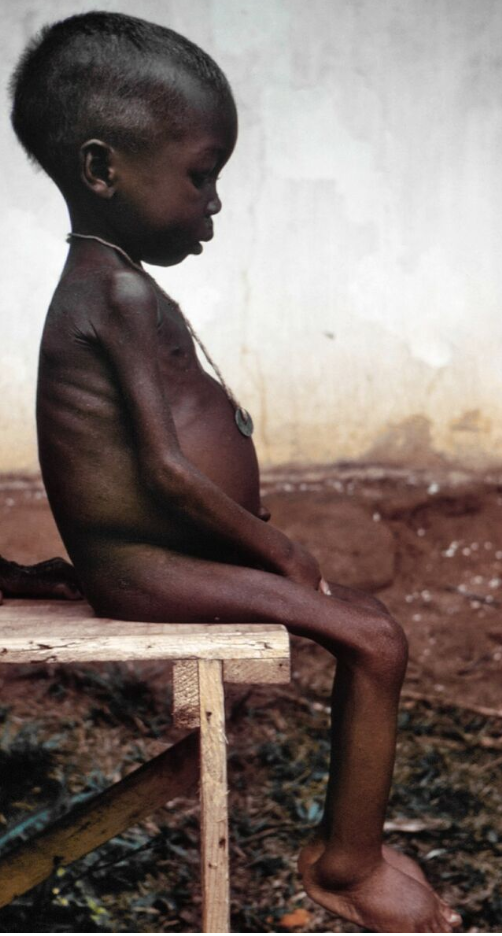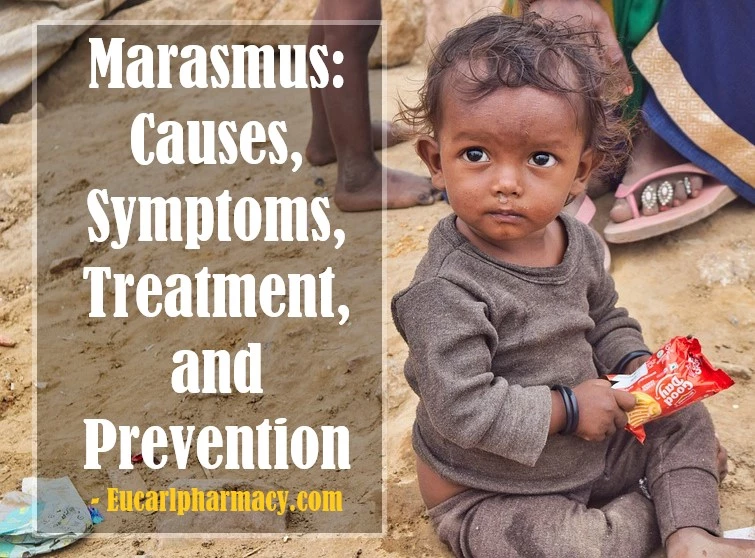Kwashiorkor: Definition, Symptoms, Causes & Treatment
The major nutrient deficiency implicated in kwashiorkor is protein and statistics have shown that most families in most developing and underdeveloped nations have more carbohydrate meals than proteinous meals.
It is evidenced in the type of menu obtainable in most families. For example, in most well-to-do or an average family in developing nations, tea and bread for breakfast, rice or noodles for lunch, and garri or processed cassava with soup are done for the day.
Only to continue the cycle of carbohydrate diets the next day and the day after. Even people living in the rural areas that are supposed to have high availability of protein-rich food have also become attached to the everyday carbohydrate meal joined with the poor environmental hygiene which makes their children more predisposed to suffering from this condition.
The preponderance of kwashiorkor is more prominent in developing and undeveloped nations when compared to the developed nations where there is a high level of sanitation, high availability of food in the right proportion, high-income rate, and good standard of living.
The age bracket mostly predisposed to kwashiorkor in the developing and underdeveloped nations is within 2 years to 6 years.
But this does not negate the fact that those outside this age bracket can suffer from kwashiorkor, it only means that occurs in people below this age bracket is minimal, because they are still been properly taken care of and the tender ones are still been breastfed and the needed nutrient for healthy growth from the breast milk.
While the body system of those above this age bracket has been well adapted to withstand a longer duration of balanced diet depreciation.
Even among people living in the developing nations, there is still a wide difference in many homes, and it has become so normal for an average family in the developing nations to eat more carbohydrates than protein as a result of the high availability of carbohydrates diet.
It has even become too bad due to the dependence of most individuals on junk. And the bad effect of this is that you hardly find protein content in most available junks that people take.
The alarming effect is that most families now rely so much on that they hardly take time to prepare a well-balanced meal enriched with protein and other beneficial nutrients for their families.
Meaning of KWASHIORKOR
Kwashiorkor is one of the two most predominant forms of protein-energy malnutrition while the second one is marasmus. Protein, as well as some required micro-minerals and nutrients, are particularly lacking in the daily diets of people with kwashiorkor.
Kwashiorkor is a mal-nutritional condition characterized by swelling in both extremities. Infants and kids are typically affected, most frequently from 2 years of age onward.
Kwashiorkor is a nutritional disorder most frequently observed in countries facing food shortages. It is also referred to as “edematous-malnutrition” due to its association with edema (fluid accumulation). Individuals suffering from kwashiorkor may appear gaunt in their limbs yet bloated in some parts of their bodies like the feet, face, tummy, and hands.
Marasmus is distinct from kwashiorkor because it is a deficiency of protein, fats, and carbohydrates (all major 3 Macronutrients) —kwashiorkor on the other hand is primarily a protein deficit.
Those who have marasmus generally lack calories so they either consume too few or deplete huge numbers, or perhaps both. Kwashiorkor patients may not lack calories in general but do lack meals high in protein.
PREDOMINANT CAUSES OF KWASHIORKOR

The eating plan that is deficient in protein
The body is made up of protein in every cell and the body needs protein in its diet to repair damaged cells and build up new ones. Lack of protein will cause the body to start shutting down its normal processes, including growth, and eventually, kwashiorkor may appear.
Predominant Carbohydrates-Heavy Diets
Frequently, a type of carbohydrates like rice, corn, or starchy vegetables is the only food that is available in most developing areas.
In contrast to foods high in protein, these crops are typically more affordable and readily available, especially in rural areas where there are a lot of agriculturalists.
Poor Nutritional Reinforcement During weaning
“Kwashiorkor” in Africa means “illness the baby seems to get when the younger sibling arrives.” The weaning child doesn’t get an adequate substitute diet because of ignorance, lack of knowledge about nutrition, inadequate resources, or perhaps any other reason, and their nourishment gradually deteriorates till it becomes a health issue.
There are still other factors that can promote the above conditions to result in someone having kwashiorkor like lack of vital minerals and vitamins, substantial life stress, dietary antioxidant deficiency, Infectious diseases, particularly malaria, measles, Human immunodeficiency virus, and parasites, and aflatoxins.
SYMPTOMS AND SIGNS ASSOCIATED WITH KWASHIORKOR
- Rust-colored skin and hair significantly alter the texture.
- Muscle mass loss.
- Inability to put on weight or to grow.
- Lethargy.
- Edema; swelling in the feet, ankles, and abdomen.
- Diarrhea.
- The immune system is compromised, which can cause quite intense and frequent infections.
- Flaky-rashes.
- Nervousness.
- Shock.
SOME EFFECTIVE MEANS OF PREVENTING AND ERADICATING KWASHIORKOR
There are some effective approaches through which the prevalence of kwashiorkor in most of the predisposed regions can be tremendously reduced or eliminated and some of them are:
Properly Educating The Public
Most people in developing or underdeveloped nations are simply unaware or ignorant of the basic nutrition for children and mothers, the health benefits of breastfeeding for the child, or the nutritional requirements after weaning.
This knowledge gap tends to result in most nutrition-related diseases like kwashiorkor. With proper enlightenment, they will be well informed and help prevent kwashiorkor in their children.
Eating Food Rich In Protein And Other Micronutrients
The major nutrient deficiency that is implicated in kwashiorkor is protein, and then other micronutrients. When the children’s diet is well enriched with these nutrients, they stay healthy and are free from kwashiorkor.
Providing Nutritional Assistance
In developing and underdeveloped nations, the WHO and some other partners are working to reinstate traditional crops that provide protein and micronutrients.
Locally sourced ingredients like peanuts and skim milk are some content of the nutritional formulas they have invented.
Maintaining Proper Hygiene
Widespread diseases and infections erode the immune systems of vulnerable populations. When the environment is not healthy, it is very easy for someone with a compromised immune state like in the case of kwashiorkor to become prone to diseases and nosocomial infections.
SOME TREATMENT OPTIONS FOR KWASHIORKOR
Even though the major nutrient implicated in kwashiorkor is proteins, some other factors contribute to having kwashiorkor as slated out by WHO and they encompass:
Restore Electrolyte Balance
Electrolyte imbalances can be dangerous, even fatal, — particularly when a malnourished individual starts re-feeding.
Treating Or Avoiding Dehydrated State
Dehydration in kwashiorkor is treated with a rehydration solution for malnutrition (RESOMAL). It not only restores the sodium and fluid balance but also maintains the balance.
Preventing Or Treating Hypoglycemia
Calories can cause hypoglycemia when they are introduced. Glucose is a component of the rehydration formula for malnourished people to aid in reestablishing balance. Over the first few hours of treatment, it is given gradually.
Initiate Intentional Feeding
The metabolism of under-nourished people is changed. When they eat again, their metabolism will alter once more. But re-feeding syndrome can suffice if this proceeds too quickly, serious problems may result especially with proteins.
Conquer Growth Behind
The child’s calories can rise to up to 140 percent of the suggested values for their age once they have stabilized and seem to be responding well to re-feeding.
Informative Education And Proper Follow-up Upon Recovery
The parent of the child should be properly educated on the benefits of balanced nutrition, breastfeeding, water, and food hygiene.
Avoid Being Infected And Treat Existing Infection
All infections pose serious risks to recovery because of the weakened immune system which emerges with kwashiorkor.
Antibiotics are employed in the treatment of all infections resulting from the compromised immune system of the person suffering from kwashiorkor.
Fill In Any Micronutrient Gaps
Deficits in a particular vitamin or mineral, whenever too intense, often have adverse implications on the person suffering from Kwashiorkor.
CONCLUSION
The prevalence of kwashiorkor is more in most countries where food supply, sanitation, or poverty. Kwashiorkor is a disease condition that is characterized by an extreme deficiency of protein in peoples day to day diets.
It is very predominant in children within the age bracket of 2 years to 6 years and can be effectively treated by a continuous gradual introduction of all the needed nutrients.

